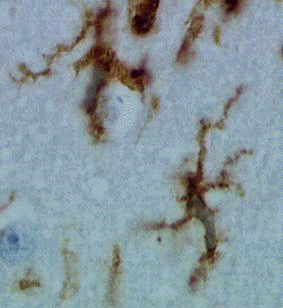 The
Microglia Home Page
The
Microglia Home Page
 The
Microglia Home Page
The
Microglia Home Page
Abandon the term "neuroinflammation"
Microglia as electricians of the brain
For today's neuropathologist it must be hard to believe that microglia were once considered an endangered species. Yet, a few years ago, it was suggested that the existence of the microglia is in doubt and that their name should be abandoned (1). What can be regarded a gross scientific error by today's standards (2,3) has a long and complicated history. Discovered independently by Nissl (4) and Robertson (5), microglia were first studied in detail by del Rio-Hortega (6). He also deserves the credit for establishing valuable knowledge on the role of microglia in CNS pathology. However, in the following years, and mainly due to a lack of cell type-specific markers, controversy arose around microglial embryonic development and their 'nature' as well as their cellular 'identity'. Thus, in the mid-1980s, microglia were "rediscovered" with the advent of immunocytochemistry and lectin markers. Meanwhile, the esoteric debate that surrounded microglia for decades had given way to research activity involving a broad circle of scientists. As a result, more than 1,000* papers have been published on microglia over the last few years. The biology and function of microglia is central to many issues in modern neuropathology. Microglia and brain macrophages have been recognized to play crucial roles in important diseases such as viral infections, autoimmunity and neurodegenerative disorders. HIV encephalitis, multiple sclerosis and Alzheimer's disease are examples where understanding the role of microglia promises to hold essential information concerning disease pathogenesis. In addition, it is becoming increasingly clear that certain molecules expressed by microglia have the potential of serving as diagnostic "sensors" in day-to-day neuropathological practice. These markers point to subtle tissue pathology that may otherwise go undetected (7-9).
The
text was taken from Graeber MB, Kreutzberg GW (1994) Brain Pathology
4: 337-9 where the references can be found. *>7,000 today
Professor Manuel Graeber on Whistleblowing
Copyright 1995-2023, published under the ICDNS general public license